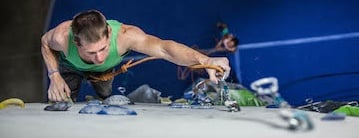A BEGINNERS GUIDE TO LEAD CLIMBING
Lead climbing, easy to learn but difficult to master. Whether you learned from a friend or took an Introduction to Sport Leading class, Movement is here to help you feel secure and confident on the wall! Take a look at these tips and tricks that can be useful if you are wondering how to continue to develop your lead climbing.
PRACTICE ON A TOP ROPE
Feeling a little uneasy about your clipping abilities? Clipping can be extremely awkward in the beginning, so don’t worry if you are having a rough time getting it perfect. Try staying attached to a top rope while using a mock lead rope to practice. This way the climber can practice clipping into the quickdraws before taking a lead check and without the fear of taking actual falls.
The most common mistake we see is back-clipping, meaning that the rope is fed through the quickdraw backwards. Remember that the rope should always be coming from behind the draw and towards the climber.
If you ever clip and are unsure, then don’t hesitate to ask your partner! Chances are, if it looks a little weird, there is probably something wrong. When in doubt, check it out! Refresh yourself on efficient clipping technique with this article from Climbing Magazine.
BELAY WITH A THIRD PERSON
Like mock lead climbing, the best way to practice lead belaying is to have the climber still attached to a top rope, meaning that you will need a third person. With the climber secured to a top rope, the mock lead belayer can practice feeding slack without the pressure of catching the climber if they fall.
The most common mistake we see is not having the right amount of slack out at any given time. There should never be so much slack that the rope touches the ground, nor should the rope be completely taught. The rule of thumb is: “a smile, not a mile”, meaning a small curve in the rope from the belayer to the wall is usually good.
POSITION YOURSELF CLOSE TO THE WALL
Lead belaying is very different than top rope belaying in many ways. Besides the fact that you are predominantly out slack rather than taking it in, your position in relation to the wall is quite different. The tendency for beginners is to stay far away as if you are top rope belaying, but that only creates more slack in the system that could be dangerous for both the climber and the belayer. You should never be more than 6 feet away from the wall at any time. Outside of that 6 foot radius, the climber has a higher potential of decking (hitting the ground) and the belayer has a higher potential of being unable to catch themselves on the wall
The most common mistake we see is not being close enough during the first three clips. The climber has the highest potential of decking in the first three clips, so the belayer should be keeping as tight a belay as possible without pulling the climber off of the wall. After the climber clips the third clip, the belayer can then take a step back, but still never leaving that six-foot radius.
Take a look at our friends’ at REI Guide to Proper Belaying
PRACTICE WITH A GRIGRI
Lead belaying with a GRIGRI requires a little getting used to if you originally learned with an ATC. However, since the GRIGRI is an assisted braking device, it can add a layer of security and can make aspects of lead belaying more efficient, so long as it's being used correctly.
The most common mistake we see with those lead belaying with a GRIGRI is leaving the thumb over the cam the entire time. In order to feed out slack quickly, you need to use your thumb to hold the cam down to prevent the device from locking up. However, you do not want to keep your thumb there the entire time because if your climber falls and you override the braking system, then your climber is going to take a potentially dangerous fall.
Check out this video from Petzl on how to properly use their GRIGRI device.
COMMUNICATE
The climber and belayer share equal responsibility to communicate with each other. Starting from double-checking each others’ harnesses, knots, and belay set up, to an open and clear dialogue between partners, allows for a safer and more efficient experience. The climber should be letting their partner know when they clip at every draw. And the belayer should be pointing out any mistakes the climber makes.
The most common mistake we see is that the belayer doesn’t call out when the climber makes a mistake. Sometimes the belayer isn’t sure whether or not they should say something, assuming their climber will be fine. But when in doubt, call it out! It is better to say something and be wrong, than to not say anything at all and jeopardize the climber’s safety.
As always, the more communication the better. See our blog post about what makes a great climbing partner.

